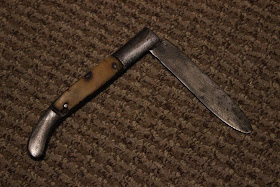Blog Guest Contributor Justin Meinert has graciously sent in a product review of an exciting new reproduction folding knife available from South Union Mills.
"Justin Meinert has been an avid reader of
"Of Sort for Provincials" since 2010 and has yet to get his book
signed. Readers are most likely to see him standing at the Forks of the Ohio,
or on a red clay hill-top in Iredell County N.C.. He is always searching to
make the hobby affordable and enjoyable for folks from Pittsburgh. He enjoys
"gasback buttons" and chicken served in a cup. "
Justin's comments and images are below.
"For any reenactor that has opened an
archeological dig from any 18th century site a particular style of clasp knife
is sure to be seen. This regularity of such a common item should lead every
reenactor to have such an item as “Pocket Trash”. Further google searches for this clasp knife
has hopefully lead you to “Cutteau Knives Revealed” a now five year old article
that the authors spell out the details to lead you to buy the perfect 18th century clasp knife.
Knives from Archaeological Investigation of Fort Ligonier, 1960-1965 by Jacob L. Grimm
However in those past five years, truly the only source for what was a common cheap knife was from custom makers with a price tag usually in excess of $200. For the purist among us these knives do not disappoint. Like a coat from Henry Cooke, these are true reproductions. However a coat has never fallen out of my pocket and traveled to a different dimension where items like socks from the dryer can never be recovered.
So like many when the email came from SouthUnion Mills, advertising for an 18th century reproduction knife I spent the money ($18 for the small, $33 for the large). But how does it compare with an original of similar size?
First the Good.
- Low Price - Reenactors are cheap….even the so called (progressives) or (librarians)
- Steel Bolsters - Most cheaper overseas produced knives for some reason have brass bolsters
- One Foot Rule- At this distance these match most details found on originals. I.e. no nail nick in the blade.
- Bolsters are two piece Overseas manufacturing making it easier to construct….this generally makes the knives thicker.
- Spring does not taper….Saving steel in the 18th century see’s tangs and springs taper..these do not again leading to a “thicker” knife.
- Blades,
although I haven't used it yet these overseas produced knives generally do
not hold an edge very well.
-Overall length opened 9.86 SUM repro vs 9.75" original
[N.B. original has had some blade tip losses as can be seen above]
[N.B. original has had some blade tip losses as can be seen above]
-Blade
length 4.40"s SUM repro vs 4.2 [N.B. original has had some blade tip losses as can be seen above]
-Thickness
at ends of bolster 0.46"s SUM repro vs 0.32 original
-Middle
thickness 0.61"s SUM repro vs 0.50 original
South Union Mills repro knife bolsters
Note how thin the original bolsters are and the taper.






